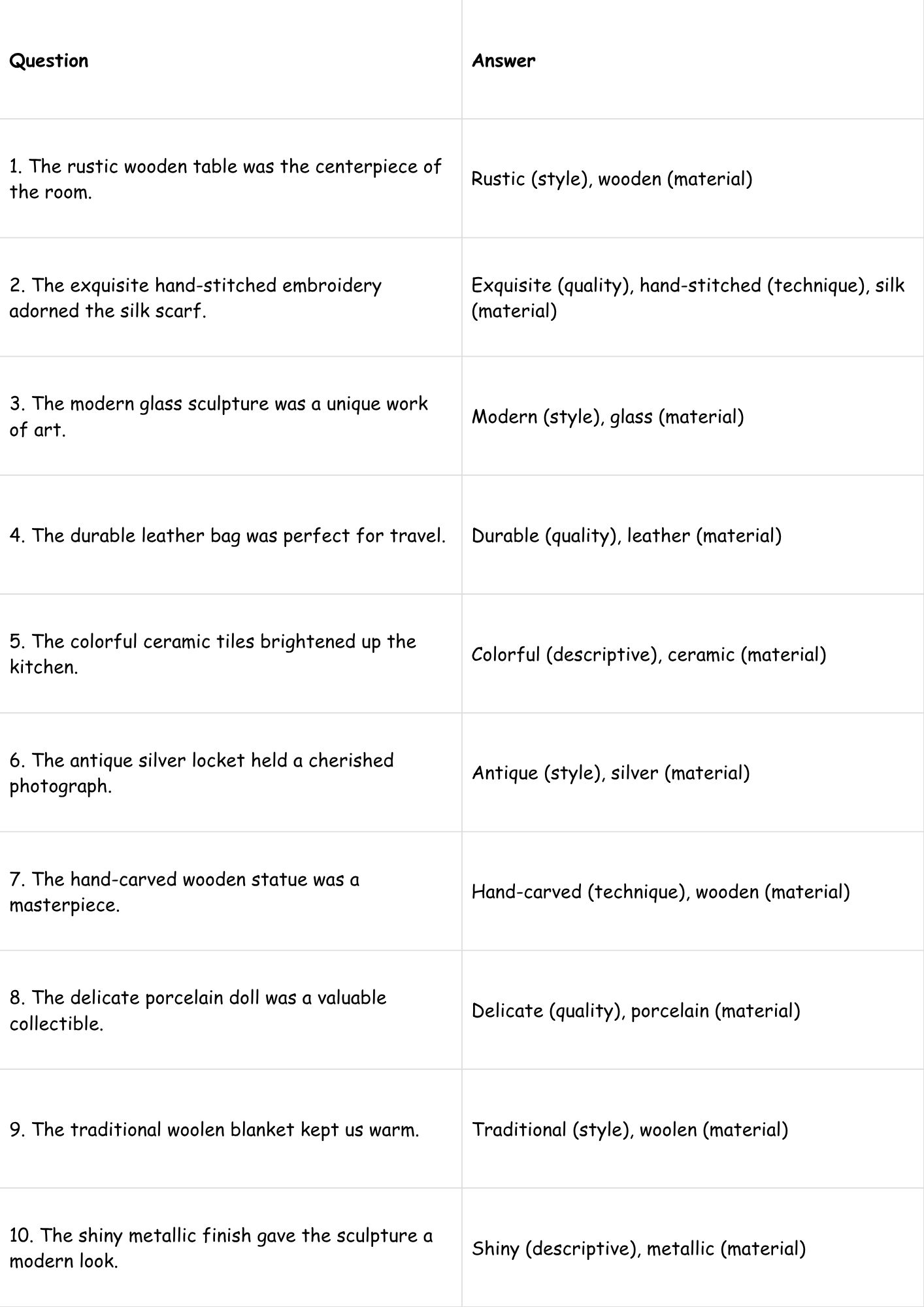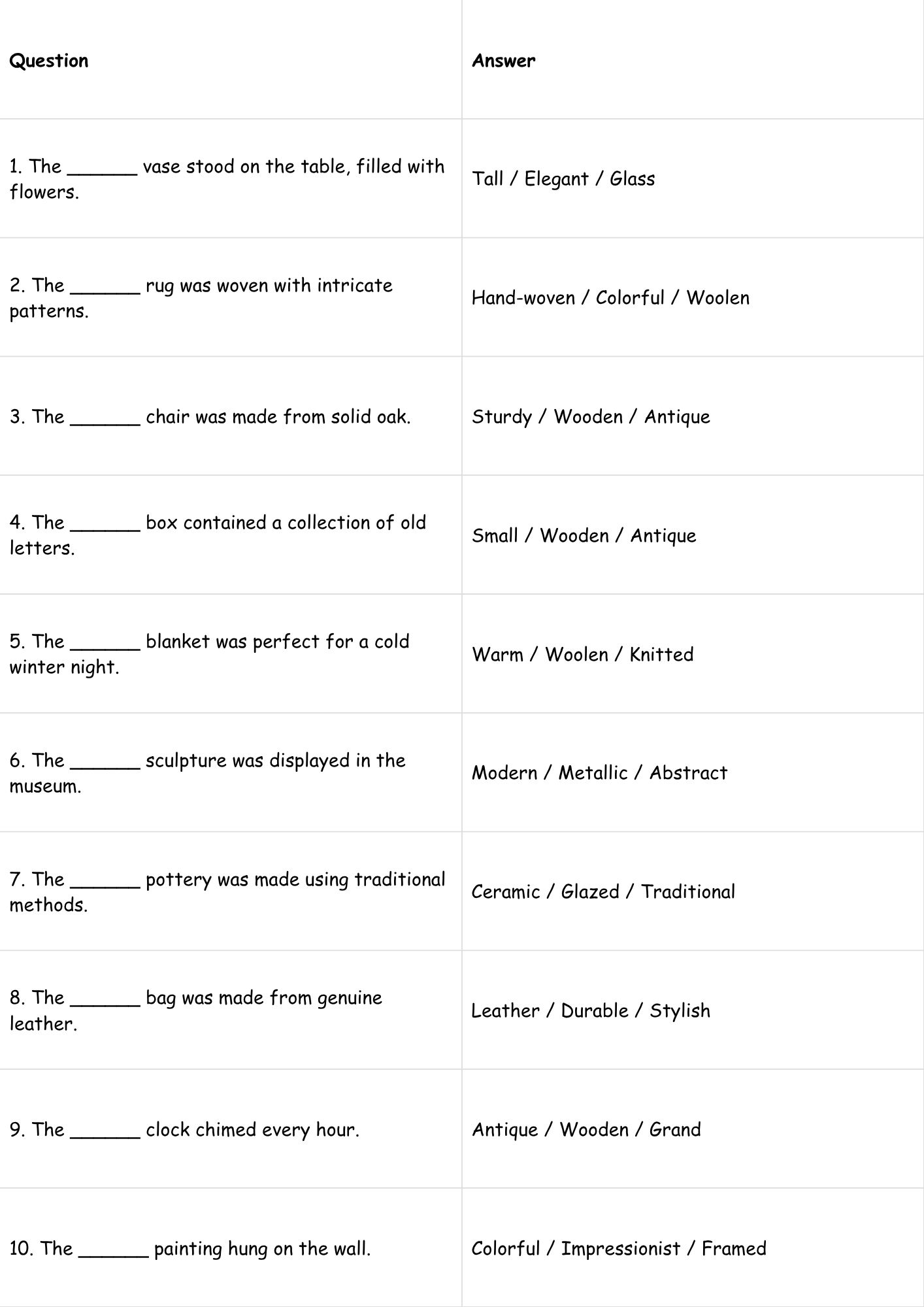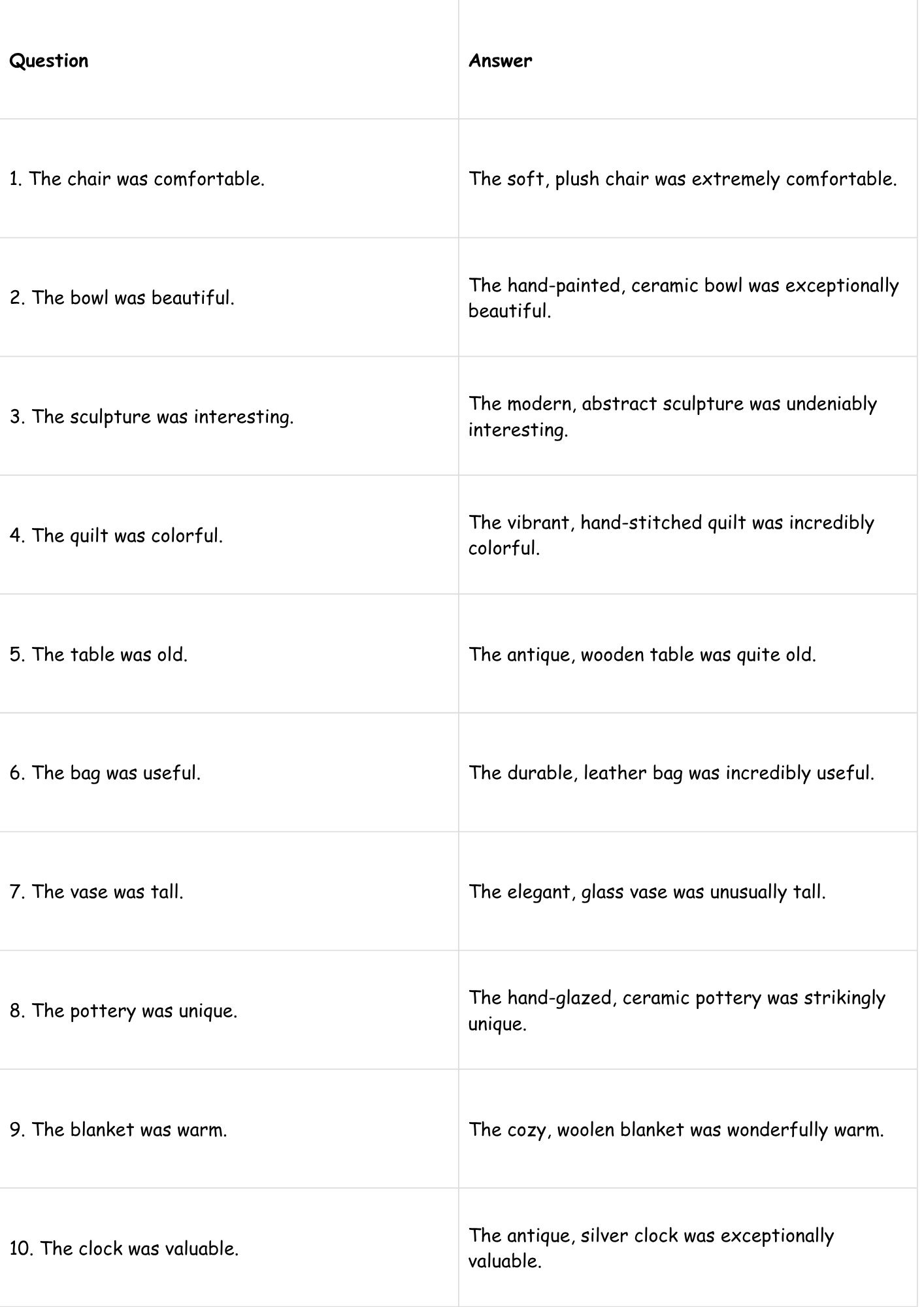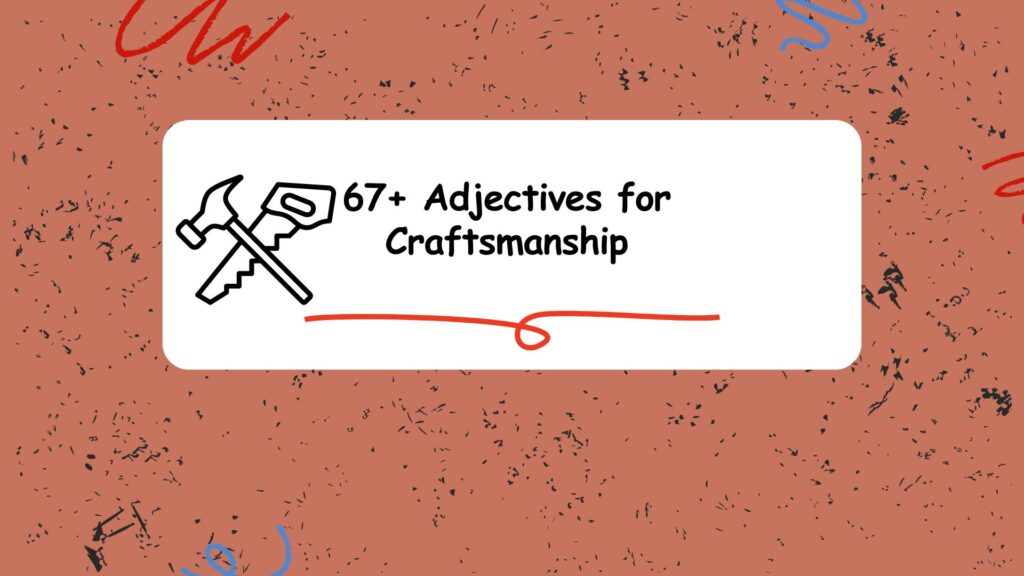Understanding the nuances of language is crucial for effective communication, especially when describing specialized fields like craftsmanship. Adjectives play a vital role in conveying the quality, style, and characteristics of crafted items. This article delves into the world of adjectives used to describe craftsmanship, providing a comprehensive guide for English language learners and anyone seeking to enhance their descriptive vocabulary. From basic definitions to advanced usage, we will explore various types of adjectives, usage rules, common mistakes, and practical exercises to help you master this essential aspect of English grammar. Whether you are a student, writer, or simply an enthusiast of fine craftsmanship, this guide will equip you with the tools to articulate your observations with precision and flair.
Table of Contents
- Introduction
- Definition of Adjectives for Craftsmanship
- Structural Breakdown
- Types and Categories of Adjectives for Craftsmanship
- Examples of Adjectives for Craftsmanship
- Usage Rules for Adjectives in Craftsmanship
- Common Mistakes with Adjectives for Craftsmanship
- Practice Exercises
- Advanced Topics
- FAQ
- Conclusion
Definition of Adjectives for Craftsmanship
Adjectives are words that modify nouns or pronouns, providing additional information about their qualities, characteristics, or attributes. In the context of craftsmanship, adjectives are essential for describing the specific features of handmade or skillfully created objects. They help to paint a vivid picture, conveying the texture, appearance, origin, and overall impression of the craftwork. These adjectives can describe the materials used (wooden, metallic), the techniques employed (hand-stitched, forged), the style or aesthetic (rustic, contemporary), or the overall quality (exquisite, durable). The effective use of adjectives enhances the appreciation and understanding of craftsmanship by highlighting its unique aspects.
Furthermore, adjectives in this context not only describe but also evaluate. They can express the skill involved, the artistry displayed, and the value attributed to the crafted item. For instance, describing a cabinet as “masterfully carved” indicates not only the carving technique but also the high level of skill demonstrated by the craftsman. The choice of adjectives can significantly impact the perception and desirability of the craftwork.
Structural Breakdown
The structure of adjective usage in sentences is relatively straightforward. Adjectives typically precede the noun they modify (e.g., “a beautiful vase“). However, they can also follow a linking verb, such as is, are, was, or were, to describe the subject (e.g., “The vase is beautiful“). Understanding these two primary positions – attributive (before the noun) and predicative (after the linking verb) – is crucial for constructing grammatically correct and effective sentences.
Adjectives can also be modified by adverbs, which further refine the description. For example, “a very intricate design” uses the adverb “very” to intensify the adjective “intricate“. Additionally, multiple adjectives can be used to describe a single noun, although it’s important to consider the order in which they appear. Generally, adjectives of opinion come before adjectives of fact (e.g., “a beautiful antique clock” rather than “an antique beautiful clock“).
Here’s a breakdown of the typical structure:
- Attributive: Adjective + Noun (e.g., polished silver)
- Predicative: Subject + Linking Verb + Adjective (e.g., The silver is polished)
- Modified: Adverb + Adjective + Noun (e.g., a finely crafted table)
Types and Categories of Adjectives for Craftsmanship
Adjectives used to describe craftsmanship can be categorized based on the specific aspects they highlight. These categories include descriptive, quality, style, material, and technique adjectives. Each category serves a distinct purpose in conveying information about the crafted item.
Descriptive Adjectives
Descriptive adjectives provide general information about the appearance, size, shape, color, or other observable characteristics of the craftwork. These adjectives help create a basic mental image of the item.
Quality Adjectives
Quality adjectives express the overall condition, durability, or value of the craftwork. They indicate whether the item is well-made, long-lasting, or of high quality. These adjectives are often subjective and reflect an evaluation of the craftsmanship.
Style Adjectives
Style adjectives describe the aesthetic or artistic style of the craftwork. They indicate the period, movement, or design principles that influence the item’s appearance. Understanding style adjectives requires familiarity with art and design history.
Material Adjectives
Material adjectives specify the materials used in the construction of the craftwork. They indicate the type of wood, metal, fabric, or other substances that make up the item. These adjectives are crucial for understanding the physical properties and potential uses of the craftwork.
Technique Adjectives
Technique adjectives describe the methods or processes used to create the craftwork. They indicate whether the item was hand-made, machine-made, carved, woven, or produced using other specific techniques. These adjectives highlight the skill and effort involved in the creation process.
Examples of Adjectives for Craftsmanship
To illustrate the different types of adjectives used in describing craftsmanship, here are several examples organized by category. These examples will help you understand how to use these adjectives in context to effectively convey the qualities of crafted items.
Descriptive Adjectives Examples
Descriptive adjectives offer a general overview of the craftwork’s appearance. The following table provides a range of examples to illustrate their usage.
| Adjective | Example Sentence |
|---|---|
| Round | The round table was meticulously crafted from oak. |
| Square | The square box held a collection of antique buttons. |
| Tall | A tall vase stood proudly on the mantelpiece. |
| Short | The short stool was perfect for reaching the top shelf. |
| Wide | A wide bowl displayed an array of colorful fruits. |
| Narrow | The narrow path led to a hidden garden. |
| Colorful | The colorful quilt brightened up the room. |
| Plain | The plain wooden box had a certain rustic charm. |
| Ornate | The ornate frame added elegance to the painting. |
| Small | The small figurine was a delicate work of art. |
| Large | A large tapestry adorned the walls of the hall. |
| Heavy | The heavy sculpture was difficult to move. |
| Light | The light fabric was ideal for summer clothing. |
| Smooth | The smooth surface of the pottery felt cool to the touch. |
| Rough | The rough texture of the stone gave it character. |
| Shiny | The shiny brass doorknob gleamed in the sunlight. |
| Dull | The dull finish of the antique mirror hinted at its age. |
| Curved | The curved legs of the chair added to its elegance. |
| Straight | The straight lines of the modern sculpture were striking. |
| Angled | The angled design of the shelf made it a unique piece. |
| Elaborate | The elaborate detailing on the clock showcased exquisite craftsmanship. |
| Simple | The simple design of the table highlighted the natural beauty of the wood. |
Quality Adjectives Examples
Quality adjectives express judgments about the craftwork’s condition and value. Here’s a table showcasing their use.
| Adjective | Example Sentence |
|---|---|
| Exquisite | The exquisite embroidery on the silk scarf was breathtaking. |
| Fine | The fine porcelain was imported from Japan. |
| Excellent | The excellent craftsmanship was evident in every detail. |
| Superior | The superior quality of the leather made it worth the price. |
| Durable | The durable material ensured the bag would last for years. |
| Sturdy | The sturdy table was built to withstand heavy use. |
| Delicate | The delicate glass sculpture was easily broken. |
| Fragile | The fragile antique vase needed careful handling. |
| Flawless | The flawless finish of the furniture showed the artisan’s skill. |
| Impeccable | The impeccable design made the product highly desirable. |
| Well-made | The well-made cabinet stood the test of time. |
| Poorly-made | The poorly-made chair fell apart after only a few uses. |
| Valuable | The valuable painting was insured for a large sum. |
| Priceless | The priceless artifact was kept under strict security. |
| Refined | The refined details of the sculpture were truly impressive. |
| Crude | The crude carving showed the artist’s lack of experience. |
| Authentic | The authentic Native American pottery was highly sought after. |
| Genuine | The genuine leather bag was made from the finest materials. |
| Exceptional | The exceptional skill of the artisan was evident in the intricate design. |
| Admirable | The admirable dedication to detail was clear in every stitch. |
| Superior | The superior craftsmanship elevated the product to an art form. |
| Masterful | The masterful control of the material resulted in a stunning piece. |
Style Adjectives Examples
Style adjectives place the craftwork within a specific artistic or historical context. The following table demonstrates their use.
| Adjective | Example Sentence |
|---|---|
| Rustic | The rustic furniture gave the cabin a cozy feel. |
| Modern | The modern design was minimalist and sleek. |
| Antique | The antique clock was a family heirloom. |
| Vintage | The vintage dress was a stylish throwback to the 1950s. |
| Contemporary | The contemporary art installation was thought-provoking. |
| Traditional | The traditional pottery was made using ancient techniques. |
| Gothic | The Gothic architecture was characterized by pointed arches. |
| Baroque | The Baroque style was known for its ornate decoration. |
| Renaissance | The Renaissance painting was a masterpiece of perspective. |
| Victorian | The Victorian furniture was elaborate and luxurious. |
| Art Deco | The Art Deco design featured geometric shapes and bold colors. |
| Minimalist | The minimalist design was clean and uncluttered. |
| Abstract | The abstract sculpture was open to interpretation. |
| Surrealist | The surrealist painting defied logic and reality. |
| Impressionist | The impressionist artwork captured the fleeting moment. |
| Futuristic | The futuristic design looked like something out of a sci-fi movie. |
| Classical | The classical architecture was inspired by ancient Greece and Rome. |
| Romantic | The romantic style featured soft colors and flowing lines. |
| Avant-garde | The avant-garde fashion pushed the boundaries of conventional style. |
| Bohemian | The bohemian style was characterized by its eclectic and free-spirited nature. |
| Industrial | The industrial design incorporated raw materials and utilitarian elements. |
| Retro | The retro style brought back the charm of past decades. |
Material Adjectives Examples
Material adjectives specify the composition of the craftwork. The following table provides examples of their usage.
| Adjective | Example Sentence |
|---|---|
| Wooden | The wooden chair was carved from solid oak. |
| Metallic | The metallic sculpture gleamed under the lights. |
| Glass | The glass vase was hand-blown by a skilled artisan. |
| Ceramic | The ceramic tiles adorned the kitchen backsplash. |
| Leather | The leather bag was crafted from genuine Italian leather. |
| Fabric | The fabric wall hanging added texture to the room. |
| Stone | The stone fireplace was the focal point of the living room. |
| Clay | The clay pot was fired in a traditional kiln. |
| Paper | The paper lanterns created a festive atmosphere. |
| Plastic | The plastic model was a detailed replica of the original. |
| Woolen | The woolen blanket kept us warm on a cold night. |
| Silk | The silk scarf was soft and luxurious. |
| Cotton | The cotton shirt was comfortable and breathable. |
| Bronze | The bronze statue stood in the town square. |
| Silver | The silver necklace was a treasured gift. |
| Gold | The gold ring sparkled in the sunlight. |
| Porcelain | The porcelain doll was a valuable collectible. |
| Marble | The marble countertop was elegant and durable. |
| Linen | The linen curtains filtered the light beautifully. |
| Acrylic | The acrylic paint created vibrant colors on the canvas. |
| Velvet | The velvet cushions added a touch of luxury to the room. |
| Denim | The denim jacket was a classic wardrobe staple. |
Technique Adjectives Examples
Technique adjectives describe the methods used to create the craftwork. The following table offers examples of their use.
| Adjective | Example Sentence |
|---|---|
| Hand-stitched | The hand-stitched quilt was a labor of love. |
| Hand-woven | The hand-woven rug was unique and beautiful. |
| Hand-carved | The hand-carved statue was a masterpiece of artistry. |
| Forged | The forged iron gate was strong and imposing. |
| Welded | The welded metal sculpture was modern and industrial. |
| Painted | The painted mural brightened up the street. |
| Glazed | The glazed pottery was smooth and shiny. |
| Embroidered | The embroidered cushion was decorated with intricate designs. |
| Knitted | The knitted sweater was warm and cozy. |
| Crocheted | The crocheted blanket was made with colorful yarn. |
| Molded | The molded plastic chair was lightweight and durable. |
| Turned | The turned wooden bowl was perfectly symmetrical. |
| Etched | The etched glass panel was a beautiful work of art. |
| Lacquered | The lacquered box had a glossy, durable finish. |
| Polished | The polished stone floor gleamed in the light. |
| Carved | The carved ivory pendant was a rare find. |
| Inlaid | The inlaid wood design was a testament to the artisan’s skill. |
| Engraved | The engraved metal plate was a personalized gift. |
| Screen-printed | The screen-printed fabric was used to make unique clothing. |
| Hand-painted | The hand-painted tiles were a charming addition to the bathroom. |
| Assemblage | The assemblage art piece combined found objects in a creative way. |
| Mixed-media | The mixed-media artwork incorporated various materials and techniques. |
Usage Rules for Adjectives in Craftsmanship
Using adjectives correctly involves adhering to specific grammatical rules. Here are some key guidelines for using adjectives in the context of craftsmanship:
- Adjective Order: When using multiple adjectives, follow a general order: opinion, size, age, shape, color, origin, material, and purpose (e.g., a beautiful small antique round blue Italian leather writing desk).
- Attributive vs. Predicative: Use adjectives attributively before the noun (e.g., a skilled craftsman) and predicatively after a linking verb (e.g., The craftsman is skilled).
- Comparative and Superlative Forms: Use comparative forms (e.g., finer) to compare two items and superlative forms (e.g., finest) to compare three or more items.
- Proper Adjectives: Capitalize proper adjectives derived from proper nouns (e.g., Victorian furniture, Italian leather).
- Hyphenated Adjectives: Use hyphens for compound adjectives that come before a noun (e.g., hand-stitched quilt).
It’s also important to consider the context and audience when selecting adjectives. Technical descriptions may require more precise and objective adjectives, while marketing materials may benefit from more evocative and subjective adjectives. Always strive for clarity and accuracy in your descriptions.
Common Mistakes with Adjectives for Craftsmanship
Even experienced English speakers sometimes make mistakes when using adjectives. Here are some common errors to avoid:
| Incorrect | Correct | Explanation |
|---|---|---|
| The wood is good. | The wood is fine. | “Good” is too general; “fine” specifies quality in craftsmanship. |
| A antique clock. | An antique clock. | Use “an” before adjectives that begin with a vowel sound. |
| The more finer detail. | The finer detail. | Avoid double comparatives (more + -er). |
| Victorian style furniture. | Victorian-style furniture. | Use a hyphen to connect compound adjectives before a noun. |
| The leather is very quality. | The leather is of very high quality. | “Quality” is a noun here; use “high quality” as an adjective phrase. |
| A hand stitched and beautiful quilt. | A beautiful hand-stitched quilt. | Adjective order matters: opinion before technique. |
| The most unique design. | The unique design. | “Unique” means one of a kind; it cannot be modified with “most.” |
| The material is wooden. | The material is wood. / It is made of wood. | “Wooden” is an adjective describing something else, not the material itself. |
| A silver beautiful necklace. | A beautiful silver necklace. | Adjective order: opinion before material. |
| The craft is gooder than the other. | The craft is better than the other. | Use the correct comparative form of “good,” which is “better.” |
By being aware of these common mistakes, you can improve the accuracy and clarity of your descriptions.
Practice Exercises
To reinforce your understanding of adjectives for craftsmanship, complete the following exercises.
Exercise 1: Identifying Adjectives
Identify the adjectives in the following sentences and indicate what type of adjective they are (descriptive, quality, style, material, or technique).
| Question | Answer |
|---|---|
| 1. The rustic wooden table was the centerpiece of the room. | Rustic (style), wooden (material) |
| 2. The exquisite hand-stitched embroidery adorned the silk scarf. | Exquisite (quality), hand-stitched (technique), silk (material) |
| 3. The modern glass sculpture was a unique work of art. | Modern (style), glass (material) |
| 4. The durable leather bag was perfect for travel. | Durable (quality), leather (material) |
| 5. The colorful ceramic tiles brightened up the kitchen. | Colorful (descriptive), ceramic (material) |
| 6. The antique silver locket held a cherished photograph. | Antique (style), silver (material) |
| 7. The hand-carved wooden statue was a masterpiece. | Hand-carved (technique), wooden (material) |
| 8. The delicate porcelain doll was a valuable collectible. | Delicate (quality), porcelain (material) |
| 9. The traditional woolen blanket kept us warm. | Traditional (style), woolen (material) |
| 10. The shiny metallic finish gave the sculpture a modern look. | Shiny (descriptive), metallic (material) |

Exercise 2: Filling in the Blanks
Fill in the blanks with appropriate adjectives to describe the craftsmanship.
| Question | Answer |
|---|---|
| 1. The ______ vase stood on the table, filled with flowers. | Tall / Elegant / Glass |
| 2. The ______ rug was woven with intricate patterns. | Hand-woven / Colorful / Woolen |
| 3. The ______ chair was made from solid oak. | Sturdy / Wooden / Antique |
| 4. The ______ box contained a collection of old letters. | Small / Wooden / Antique |
| 5. The ______ blanket was perfect for a cold winter night. | Warm / Woolen / Knitted |
| 6. The ______ sculpture was displayed in the museum. | Modern / Metallic / Abstract |
| 7. The ______ pottery was made using traditional methods. | Ceramic / Glazed / Traditional |
| 8. The ______ bag was made from genuine leather. | Leather / Durable / Stylish |
| 9. The ______ clock chimed every hour. | Antique / Wooden / Grand |
| 10. The ______ painting hung on the wall. | Colorful / Impressionist / Framed |

Exercise 3: Rewriting Sentences
Rewrite the following sentences, adding more descriptive adjectives to enhance the description of the craftwork.
| Question | Answer |
|---|---|
| 1. The chair was comfortable. | The soft, plush chair was extremely comfortable. |
| 2. The bowl was beautiful. | The hand-painted, ceramic bowl was exceptionally beautiful. |
| 3. The sculpture was interesting. | The modern, abstract sculpture was undeniably interesting. |
| 4. The quilt was colorful. | The vibrant, hand-stitched quilt was incredibly colorful. |
| 5. The table was old. | The antique, wooden table was quite old. |
| 6. The bag was useful. | The durable, leather bag was incredibly useful. |
| 7. The vase was tall. | The elegant, glass vase was unusually tall. |
| 8. The pottery was unique. | The hand-glazed, ceramic pottery was strikingly unique. |
| 9. The blanket was warm. | The cozy, woolen blanket was wonderfully warm. |
| 10. The clock was valuable. | The antique, silver clock was exceptionally valuable. |

Advanced Topics
For advanced learners, exploring more complex aspects of adjective usage can further enhance their understanding. This includes delving into nuanced meanings of adjectives, understanding the impact of adjective choice on tone and style, and exploring the use of figurative language with adjectives.
Consider the subtle differences between adjectives like “refined” and “sophisticated.” While both describe high quality, “refined” often implies a delicate precision, while “sophisticated” suggests a more worldly elegance. Similarly, exploring the use of metaphors and similes with adjectives can add depth and imagery to your descriptions (e.g., “The glass was as clear as a mountain stream“).
Furthermore, analyzing the use of adjectives in different types of writing – such as technical reports, marketing copy, and literary descriptions – can provide valuable insights into how adjectives are used to achieve specific communication goals. Understanding these advanced topics will enable you to use adjectives with greater precision and artistry.
FAQ
Here are some frequently asked questions about using adjectives for craftsmanship:
- What is the correct order of adjectives when describing craftsmanship?The general order is: opinion, size, age, shape, color, origin, material, purpose. For example: “a beautiful small antique round blue Italian leather writing desk.” However, prioritize clarity and natural flow over strict adherence to this order.
- How can I avoid using too many adjectives in a sentence?Prioritize the most relevant and impactful adjectives. Consider using stronger verbs or more descriptive nouns to convey information instead of relying solely on adjectives. Break long sentences into shorter ones for better readability.
- What is the difference between “hand-made” and “handmade”?“Hand-made” (with a hyphen) is typically used as an adjective before a noun (e.g., “a hand-made gift”). “Handmade” (without a hyphen) can be used as an adjective or a noun (e.g., “This gift is handmade,” or “This is a handmade”).
- How do I choose the right adjective to describe a specific craft technique?Research the technique and its characteristics. Look for adjectives that accurately convey the process, skill, and resulting texture or appearance. Consult specialized dictionaries or glossaries related to the craft.
- Are there any adjectives that should be avoided when describing craftsmanship?Avoid overly general or vague adjectives like “good,” “nice,” or “interesting.” These adjectives lack specificity and do not provide meaningful information about the craftwork. Also, avoid clichés and overused phrases.
- How can I improve my vocabulary of adjectives for craftsmanship?Read widely about different types of crafts, visit museums and galleries, and pay attention to the language used to describe the items. Use a thesaurus to find synonyms and explore the nuances of different adjectives. Practice using new adjectives in your writing and speaking.
- Is it okay to use subjective adjectives when describing craftsmanship?Yes, subjective adjectives (e.g., “beautiful,” “elegant”) can be used, especially in marketing materials or personal descriptions. However, balance subjective adjectives with objective adjectives (e.g., “hand-stitched,” ”
metallic”) to provide a well-rounded description. Clearly indicate when you are expressing a personal opinion.
Conclusion
Mastering adjectives for craftsmanship is an ongoing journey that combines linguistic knowledge with an appreciation for the artistry and skill involved in creating crafted items. By understanding the different types of adjectives, adhering to usage rules, avoiding common mistakes, and continuously expanding your vocabulary, you can effectively communicate the unique qualities and characteristics of craftwork. Whether you are describing a simple wooden bowl or an elaborate tapestry, the careful selection of adjectives will enhance your ability to convey the beauty, value, and significance of craftsmanship.



